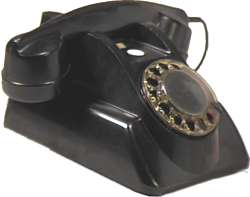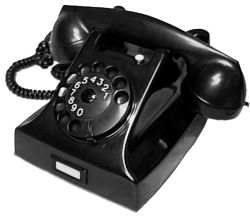Some history on phones from the Netherlands
 Since
I knew virtually nothing about these phones when I posted them to this
web site, I was very glad to receive some detailed information from a
pair of very helpful Netherlanders:
Since
I knew virtually nothing about these phones when I posted them to this
web site, I was very glad to receive some detailed information from a
pair of very helpful Netherlanders:
In 1950 the Dutch PTT (Post, Telefoon en Telegraaf; the state owned post and telecommunication operator) asked three companies to construct a new model telephone set. PTT designed the "inside", the companies were left free to design the outside. The three companies were the Dutch Ericsson establishment, HEEMAF and NSEM/ITT. In 1951 the companies came with their design, PTT called them "model 1951". The sets are used until the 90's The HEEMAF telephone was designed by the Dutch industrial designer Gerard Kiljan. Probably somewhere on the metal footplate there is a production date. The Ericsson Ruen (I did not know the set was called like that) is Ericssons model 1951. So the inside of your HEEMAF en Ericsson set is the same! The white button, on the model 1951 is the so called "earth" button. (Not known in the US??) It is the ancestor of the "flash" button for instance for connecting a caller with someone else on the PABX (Automatic Telephone Exchange).
After I received the above message, I reexamined these phones, and indeed their internals are very similar. This HEEMAF phone is identified as a "TYPE 1955" on the schematic inside, but it's covering an older schematic, so perhaps the guts were updated after the phone was manufactured. The date stamp on the bottom of this phone is 1-69.
Trying to find out more about the industrial designer Gerard Kiljan, (I could find NOTHING online, or in libraries here in the US except vague references to photography and graphic design.) I wrote to the Museum voor Communicatie (Museum for Communication) in The Hague in The Netherlands, and got a very nice response from Jacques Caspers, the curator of telecommunication: (I'm paraphrasing here)
About Gerard
Kiljan (1891-1968) the Dutch industrial designer: In the fifties, the
Dutch PTT engaged him to design an integrated telephone in a functionalist
style. It was manufactured by the Heemaf factory in Hengelo (east of our
country) and appeared on
the market in 1955.
The construction
inside is simular as in the Ericsson 1951  and
the Standard Electric model of 1954, and comply with the strict standards
of the Dutch PTT, controlled by their laboratory in Leidschendam.
and
the Standard Electric model of 1954, and comply with the strict standards
of the Dutch PTT, controlled by their laboratory in Leidschendam.
The Ericsson model was manufactured at the Dutch plant of Ericsson in Ryen (Rijen) in the south of the country. The Standard Electric telephones came from the BTMC plant in Antwerp (Belgium) and maybe also from the Dutch plant in The Hague.
Originally Gerard Kiljan was a graphic designer. In 1931 he designed also for PTT (at that time called : Rijkstelefoondienst) a series of stamps (subject: children) and a leaflet for the telephone company. In that time he was a teacher at the Royal Academy of Expressive Arts in The Hague and some years later in Rotterdam. He was strongly influenced by the principles of the design movement called : Nieuwe Zakelijkheid (New Objectivity). Contemporaries are the designers Henry Cahn and Piet Zwart.
Until the fifties Kiljan was not active as an industrial designer. He was more interested in photographic experiments. Kiljan's telephones (beside the table model there is also a wall model) have for some time now become coveted objects for collectors and design freaks.
Introduction
Automatic Electric | Western Electric | Other US | International | Intercoms

Tell me about all the factual errors in this page, or add to my knowledge with the story about your father who worked at the plant.